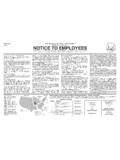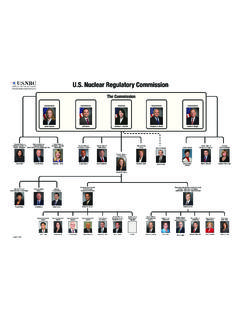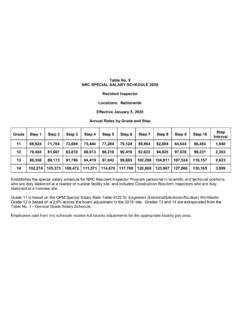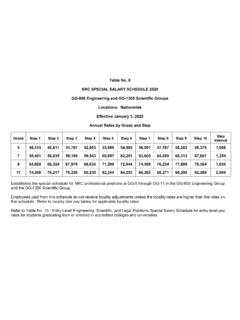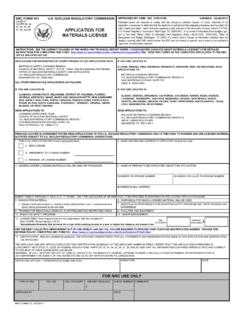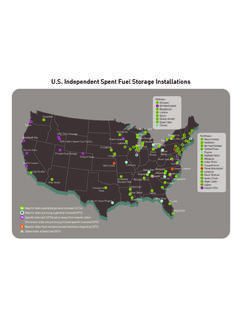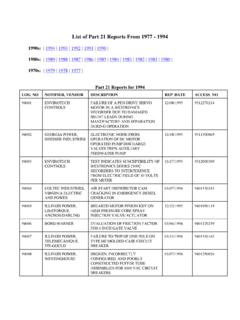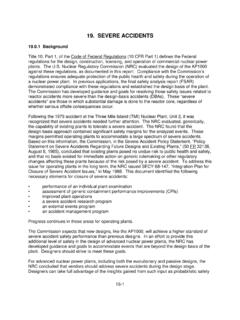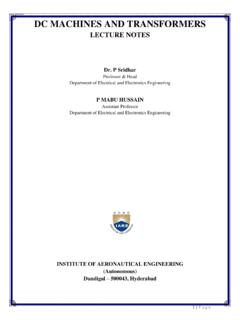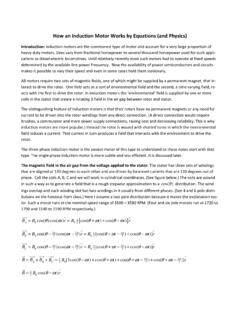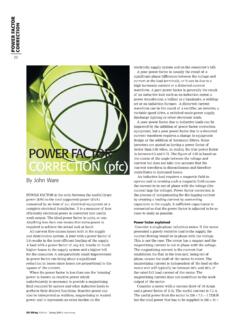Transcription of 9.0 GENERATOR, EXCITER, AND VOLTAGE REGULATION
1 Emergency Diesel Generator The Generator, Exciter, and VOLTAGE REGULATION Rev 1/11 9-1 of 34 USNRC HRTD GENERATOR, EXCITER, AND VOLTAGE REGULATION This chapter presents the major components of the electrical generator, the exciter, and the VOLTAGE regulator and explains how they relate to the development of power by the diesel engine driven generator unit. Learning Objectives As a result of this lesson, you will be able to: 1. Describe the functions of the generator, exciter, and VOLTAGE regulator.
2 2. Identify the major components of the generator and how they inter-relate. 3. Describe how diesel engine output power relates to the power demands of the generator. 4. Describe the function of the excitation system and the associated VOLTAGE regulator. 5. Identity the major components of the exciter and VOLTAGE regulator system. Generator Principles The following is a brief discussion of generator operation and its relationship to the mechanical load placed on the diesel engine.
3 Electromagnetic induction Electromagnetic induction , the basic principle of generator operation, involves the movement of an electrical conductor through a magnetic field. Figure 9-1 shows the principles being discussed in this section. As the conductor passes through the magnetic field, in this case downward, it cuts each of the lines of magnetic force (flux) which causes a current to be "induced" in the conductor. Because the conductor has a resistance, it is known from 'ohms law' that the VOLTAGE is equal to the current times the resistance.
4 Therefore, a VOLTAGE is also 'induced' between the two ends of the conductor. If the conductor is connected to a closed electrical circuit, this VOLTAGE would cause a current to flow. The amount of current flow is a function of the VOLTAGE induced and the electrical resistance of the load in the circuit. Induced VOLTAGE The actual VOLTAGE induced in the conductor is determined by the number of lines of flux cut per unit of time. Two key factors affect the magnitude of VOLTAGE induced.
5 The speed at which the conductor moves through the fixed magnetic field and the strength of the magnetic field determine the output VOLTAGE . This speed is a function of the rotational speed (RPM) of the generator/engine. As the speed of the engine the generator increases, the VOLTAGE produced also increases. Since the operating speed of the engine and generator is constant in order to maintain the desired frequency, another method of VOLTAGE control must be employed.
6 Generator output VOLTAGE is most often Emergency Diesel Generator The Generator, Exciter, and VOLTAGE REGULATION Rev 1/11 9-2 of 34 USNRC HRTD controlled by regulating the strength (flux intensity) of the magnetic field. This is accomplished by the generator excitation system. The excitation system monitors the generator output and regulates the magnetic field to maintain the desired VOLTAGE . As the load on the generator is increased, an increase in current flow causes the VOLTAGE to drop.
7 The excitation system senses this decrease in VOLTAGE and increases the strength of the magnetic field to return the VOLTAGE to the desired level. How the generator works Figure 9-2 shows the principles discussed above implemented into a machine to produce a VOLTAGE . In this implementation, a U shaped form is provided with a gap between the open ends of the U . A coil of wire is wrapped about the legs of this form to produce a magnetic field across the gap. In the gap, an armature is formed by a loop of wire.
8 The loop exits the armature onto two slip rings. The slip rings are contacted by brushes that connect the generator to the outside electric circuit. An engine or some other prime mover is connected to the armature causing it to rotate inside the gap. When the field coil is energized to establish a magnetic field/flux in the gap and the armature is then rotated, a VOLTAGE is generated in the armature. The slip rings and brushes conduct this VOLTAGE out to some load "A.
9 " Figure 9-3 shows a blowup of the armature in the gap. As the armature is rotated in its initial position, no VOLTAGE is created because the magnetic flux is equal but opposite on both branches of the loop. This is shown in the part of the diagram labeled 'Start.' As the armature is turned to a position 90 degrees from the first, the two ends of the loop is acted upon in a manner wherein the voltages generated at each end of the loop are additive, as shown in the '1/4-cycle' diagram.
10 Peak output VOLTAGE is generated at each cycle point. As the armature continues to rotate, it again gets to a position of no VOLTAGE generation, shown in the -cycle diagram . As the rotation continues, a VOLTAGE is again generated. A close examination of the wiring out of the armature reveals that the connections have become inverted. This results in the opposite polarity of VOLTAGE . The diagram at the bottom of the figure shows the resulting build-up and decay and opposite polarity build up and decay again through two cycles (two rotations of the armature).
